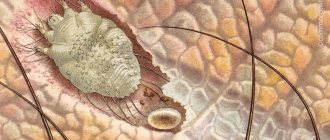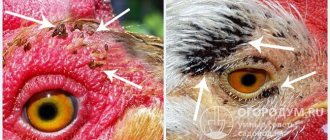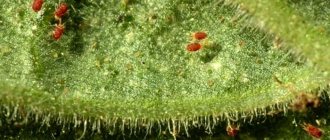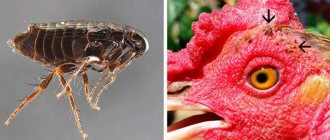Another common type of ectoparasite (external) is ticks in dogs. When people talk about ticks and how dangerous it is in the warm season, they mean one of the types of skin parasites – ixodid ticks (Ixodidae). In fact, several species of these arthropods parasitize dogs. Some of them gnaw the skin of animals, others suck blood, and for others, the lymph and skin secretions of your pet are a source of food. As a result of the activity of ticks, the animal may develop a severe allergic reaction, viral and bacterial diseases, as well as abscesses and dermatitis.
Where can a dog catch a tick?
The danger of infection with ixodid ticks appears in the warm season. Ticks become active in early spring and go into hibernation only in late autumn, when the first frosts occur. The most dangerous time is the end of May and the beginning of June. These carnivorous arthropods have special thermal sensors with which hungry parasites find prey.
Ticks sit on tall grass or bushes, waiting for prey. As soon as a dog passes by, the little parasite makes a jump, grabs the animal’s fur with its tenacious tentacles and begins to look for a place free of hair. When such a place is found, and this could be the groin area, parotid area, legs, stomach or neck, the tick pierces the skin and begins to suck blood.
Infection with other types of ticks occurs mainly through care items contaminated with parasite eggs: beds, bedding, dog toys. The second method of infection is contact.
Which places especially need protection from tick bites?
In greatest danger: the head, neck, especially the ears, cheeks, the area behind the ears, in second place is the area between the toes, stomach, chest, groin. Ticks can also easily attach themselves to any other part of the body (back, shoulders, hips), but less frequently.
Ticks rarely bite the back, but this part of the body has a very large area that a tick can easily get into, which means that if you treat the back well, the tick will receive a lethal dose of the substance while crawling higher up it, towards the head. Therefore, it is worth paying special attention to these places.
Types of ticks
So, there are three types of ticks that parasitize dogs:
- Ixodes. The largest tick that feeds on the blood of animals.
- Subcutaneous mite (demodectic mite). It feeds on epithelial cells and blood.
- Scabies (internal, ear). Feeds on epidermal tissues.
Ixodid ticks
Parasites wait for their victims on the street: in the forest, on a dog-walking area, in the country, in public gardens and parks. Despite the painful symptom, ixodid tick bites themselves do not pose any particular danger. Much more dangerous than the diseases that a tick can infect a dog with.
Attached ixodid ticks are revealed by visual inspection of the animal's body - these are small brown bubbles with legs. If your dog's fur is very thick, you may not notice parasites right away. The situation is complicated by the fact that the tick can suck blood and fall off unnoticed.
Symptoms of a tick bite in a dog:
- weakness, the animal is lethargic, constantly lying down;
- thready pulse;
- loss of appetite;
- the whites of the eyes acquire a jaundiced tint;
- urine darkens: brown, brown;
- vomiting with bloody mucus;
- hyperthermia (40°-42°C);
- difficulty breathing, shortness of breath;
- swelling;
- lameness.
Dangerous diseases caused by tick bites
- Piroplasmosis (canine encephalitis). The encephalitis tick poses the greatest danger to young purebred animals. Without timely, properly selected treatment, the mortality rate from this disease can reach 100%.
- Lyme disease (borreliosis). A widespread disease with a long incubation period - up to 2 months. Detected by a laboratory blood test. Treatable if detected early.
- Ehrlichiosis. The incubation period is 7-20 days. The disease is common in tropical and subtropical regions. In progressive cases, death is possible.
Sometimes, after removing the tick, a reddened lump remains on the dog’s body. This is not a symptom of a dangerous disease, it is the result of an allergic reaction to chemicals in the bloodsucker's saliva. All you need to do is lubricate the seal with brilliant green and prevent the dog from scratching this area.
Dog lovers should know what to do if their dog is bitten by a tick. First, you need to properly remove the attached parasite at home or in a veterinary clinic. Secondly, submit the removed insect for analysis. Third, take the dog to a veterinarian for diagnosis and treatment.
Subcutaneous mites
The peculiarity of this type of parasite is that they live in the internal organs, hair follicles and sebaceous glands of any dog. If an animal has excellent health and strong immunity, its body independently controls the number of uninvited guests. But as soon as the animal’s body weakens and the immune system fails, the tick begins to multiply uncontrollably - this leads to the development of a disease such as demodicosis. Popularly, this pathology is often called red scabies or scabies.
The first signs of the disease:
- bald patches appear on the animal’s body;
- the skin in areas of bald patches becomes rough, peels, becomes covered with scales and thickens;
- pink or red rashes appear in areas without fur, sometimes with purulent contents;
- the dog experiences severe itching, constantly scratches, injuring itself;
- the hair changes its structure, becomes dull, brittle, and shaggy;
- in long-haired breeds, shortening of the guard hairs is possible;
- Dandruff may appear.
The main forms of demodicosis:
- Focal (localized). Dogs up to one year of age are susceptible. It is characterized by the appearance of several bald patches with rough, flaky skin. In the vast majority it goes away on its own. Only 10% of cases become generalized.
- Generalized. Bald patches gradually spread throughout the dog's body. Inflammation develops and the skin develops an unpleasant odor. Older individuals have a less favorable prognosis for full recovery.
- Juvenile. Hereditary disease. Puppies up to one year of age are susceptible. Favorable prognosis for cure.
- Pododemodicosis. A disease with a lesion on the paws. The weak point of cocker spaniels. Bald patches, boils, purulent inflammation, and erythema appear on all limbs.
- Otodemodecosis. Inflammation of the outer ear. Bald patches appear around the ear. Black crusts form in the ears. The dog is experiencing severe itching.
Regardless of its form, ironworm is considered a non-contagious disease. The main reason for the appearance of bald patches, itching and painful areas of the skin is weak immunity. To reduce the risk of this pathology, the dog owner must take care of improving the health of his pet.
Scabies mites
This group of parasites includes two types of mites: scabies (internal) and ear mites (cutaneous). These are microscopic arthropods that resemble crabs in appearance. Once on the dog's skin, the parasites begin to multiply very quickly. Tick colonies in advanced cases can number up to several thousand individuals.
Signs of scabies mite infestation:
- the dog experiences severe itching, because of this it constantly itches, shakes its head, scratches itself;
- Scabs appear in places where scratching occurs;
- Foci of redness and blisters with cloudy liquid appear on the ears, eyebrows, bridge of the nose, at the root of the tail, on the stomach, in the chest area and on the head;
- the skin in places of irritation becomes rough;
- the dog's hair changes its structure: it becomes dull, coarser, and a shaggy effect appears;
- in places of pathological foci, hair falls out intensively;
- dermatitis develops;
- the skin becomes rough, cracks, and an “elephantiasis” effect appears;
- large dandruff appears - particles of dead epidermis;
- the animal is worried, sleeps poorly;
- The dog loses its appetite and becomes exhausted.
The main question that worries dog owners is whether a dog can die from infection with scabies mites. The answer is disappointing - maybe, if treatment is not started in time. The death of the animal occurs from general exhaustion of the body.
Diseases caused by the scabies mite:
- Sarcoptic mange. Caused by itching of the genus Sarcoptes. Locations affected: head, abdominal area, root of the tail, sternum area.
- Notoedrosis. Invasive disease. The causative agent is the Notoedres mite. Location: dog’s head: forehead, brow ridges, nose. In advanced cases, it can spread to the limbs.
- Otodectosis. Ear scabies is a contagious disease. The causative agent is the small white tick Otodectes cynotis. Parasites are localized in the ear. The skin of the shells turns red, ulcerates, and becomes covered with dark crusts. It is characterized by severe itching. Without treatment, it can spread to the head and entire body. The danger of the disease is that inflammation can spread to the inner and middle ear, meninges. This provokes nervous attacks and can cause the death of the dog.
The clinical picture of scabies resembles other diseases: dermatitis, demodicosis, eczema of the auricle. Therefore, a final diagnosis can only be made within a veterinary clinic based on the results of laboratory tests.
Treatment
Treatment of demodicosis caused by subcutaneous mites is a long and difficult process. Its complexity is that often this disease develops against the background of a decrease in the body’s defenses and has accompanying skin problems. Therapy tactics include suppressing the parasite, treating underlying diseases and increasing immunity.
The most commonly used local therapy is lotions and special ointments. In more severe cases, the doctor prescribes a course of antibiotics in combination with external therapy. Sometimes plasmapheresis procedures are recommended. In special cases, even surgical intervention is possible.
An important point in the course of treatment is diet. It is necessary to exclude hot, spicy and salty foods, foods rich in carbohydrates and fats from the diet. Those who are being treated for subcutaneous mite infestation are recommended to consume large amounts of fruits, vegetables, microelements, fiber, and dairy products. During treatment, you should not use face masks, especially those containing honey. You need to limit your exposure to the sun. You should also wait until better times to visit the bathhouse and sauna.
How to remove a tick from a dog
A tick removed in a timely manner is a chance that the animal did not have time to become infected with anything. All parasites found on the dog's body must be removed. This must be done by adhering to the following rules:
- If a tick has attached itself to your pet, forget about the common advice - do not use vegetable oil or gasoline to pre-treat the insect. This will kill the bloodsucker, but at the moment of death he will release the contents of his stomach into the dog’s blood - dangerous infections will occur.
- All you need to remove is tweezers and rubbing alcohol. The body of the parasite and the place where it has attached itself to the skin are moistened with alcohol or its analogue.
- When the alcohol takes effect and the dog’s tick slightly relaxes its proboscis, begin to remove it.
- The parasite is grabbed with tweezers and slowly and carefully twisted counterclockwise. The tweezers should be held parallel to the skin or at a slight angle so as not to damage the bloodsucker's body.
- If the head of the tick remains inside the dog's skin, it is necessary to immediately show the animal to a veterinarian.
After removing the insect, it is submitted for analysis, and the pet is closely monitored in order to notice in time changes in the dog’s behavior after the bite and a possible deterioration in its condition.
Important! Remember that many dangerous diseases transmitted through parasite saliva have a long incubation period.
Vaccination, for what purpose is it performed?
There are a number of remedies, such as: Nobivak Piro, Eurikan Piro and Pirodog, aimed at smoothing out the symptoms of piroplasmosis. When an animal is bitten by a tick, an acute form of piroplasmosis is not observed. It is believed that vaccination is not very well tolerated by internal organs, as it is relatively toxic.
One way or another, if the symptoms of piroplasmosis are pronounced, the administration of the antidote will have to be repeated. This treatment method is suitable for dogs with a wandering lifestyle in tick-prone regions.
Diagnostics
Diagnostic measures begin with collecting anamnesis and differ depending on the type of ectoparasite. Ixodid ticks can be identified by visually inspecting the animal's body after each trip outside. The found parasite is carefully removed and sent for analysis to a veterinary clinic. Blood is taken from the dog to make a diagnosis.
If the bloodsucker is not found, monitoring the condition and behavior of the dog helps in making a diagnosis. When the first symptoms of the suspected disease appear, an urgent visit to the veterinarian is necessary for laboratory tests.
The clinical manifestations of infection with subcutaneous and scabies mites are very similar, so the diagnosis is made only after laboratory tests of superficial and deep skin scrapings. Scrapings are made in a medical facility using sterile sharp cutting objects in places where the pathology is localized. After this, microscopic examinations are carried out to identify parasites, their larvae and eggs. Depending on the type of mites detected, further treatment is prescribed.
Article information
This article was co-authored by. Dr. Elliott, BVMS, MRCVS is a veterinarian with over 30 years of experience in veterinary surgery and the care of companion animals. She graduated from the University of Glasgow in 1987 with a degree in Veterinary Medicine and Surgery. He has been working at the same animal clinic in his hometown for over 20 years.
Category: Dog Health
In other languages:
English: Get Ticks off Dogs, Español: quitar garrapatas a los perros, Português: Tirar os Carrapatos do Seu Cachorro, Deutsch: Einen Hund von Zecken befreien, Français: enlever une tique à un chien, Italiano: Togliere le Zecche dai Cani, 中文: ? เห็บหมา, العربية: إزالة القراد من الكلاب, Tiếng Việt: Loại bỏ ve chó
This page has been viewed 49,247 times.
Was this article helpful?
Not really
Anti-tick medications for dogs
Since dogs are susceptible to infection by three types of ticks, veterinary medicine uses targeted drugs that are active against one type of parasite. In addition, the pet industry produces products to prevent infection.
Medications are available in several forms:
- ointments;
- aqueous emulsions;
- liniments;
- pills;
- oil solutions;
- drops;
- injections;
- shampoos;
- aerosols and aerosol foams.
Preventive measures:
- tick collar;
- drops on the withers;
- anti-tick spray.
Effective treatments for ticks
In modern veterinary medicine, to get rid of tick-borne infestations, the following are used:
- Sulfur-tar ointment (AVZ). An effective domestic cure for scabies.
- Dectomax (USA). Injection for the treatment of demodicosis (subcutaneous mite).
- Delcid (AVZ). Therapeutic and prophylactic emulsion against tick infestation.
- Bravecto (MSD Animal Health). Anti-tick tablets.
- Vio (Beaphar). Drops on the withers against fleas and ticks.
- Lawyer (Bayer). Drops against scabies mites.
- Tropiclean "Maximum protection". Anti-tick shampoo.
- Stronghold. The best drops against ear and scabies mites.
- Yam BK (AVZ). Ointment against scabies and dermatitis.
- Ivermek. Injectable drug against sarcoptic mites.
- Frontline (Merial). Tablets for killing ticks.
The following are used as protective and preventive agents:
- Bars (AVZ). Spray with insectoacaricidal effect.
- Foresto (Bayer). Anti-tick and flea collar.
- Mr Bruno. Spray against ixodid ticks.
- Rolf Club. Anti-parasite spray.
- Inspector. Therapeutic and prophylactic drops.
- Anti-mite. Ultrasonic repeller.
How to use medications correctly
We described how to properly remove ixodid ticks just above in this article. Let's talk about how to properly organize treatment for a dog in cases of infection with subcutaneous and scabies mites.
The first thing a dog owner should do after an accurate diagnosis has been established is to isolate the animal from other pets. After this, the sick animal must be thoroughly washed with tar soap. This is necessary in order to cleanse the dog's skin of scabs, dandruff, oil and dirt.
At the end of bathing, to enhance the effect and reduce itching, the animal is rinsed with decoctions of medicinal herbs: chamomile, string or celandine. After water procedures, the dog is thoroughly dried with a dry cloth and kept in a heated room until the fur is completely dry.
The fur in areas affected by ticks is shaved. Wounds and scratches on the skin are treated with antimicrobial ointments. To do this, you can use drugs from the owner's first aid kit: Vishnevsky ointment or Konkov suspension.
After this, the mite-infested areas of the skin are treated with medications prescribed by the veterinarian. The doctor selects an individual treatment regimen for each dog, taking into account its age, breed, health status and existing chronic diseases. It is unacceptable to treat a dog without an accurate diagnosis, selecting medications yourself. Rehabilitation of an animal after an ixodid tick bite should also be carried out under the supervision of a veterinarian .
Insect Collar
The best option for a dog that is regularly exposed to danger is a special collar. This accessory will prevent ticks from attacking in the most unprotected area. Insects are often localized on the pet's neck, since this area is inaccessible to the dog. Collars are made of polyvinyl chloride. They are impregnated with chemicals and plant compounds. Strong odors repel not only ticks, but also fleas and mosquitoes. These accessories have several advantages. They:
- do not come into contact with skin, eliminating the risk of allergies;
- do not cause discomfort to the dog;
- convenient to use.
The collar is placed on dry hair, which does not allow chemicals to reach the skin. If the dog has been walking in the rain, it needs to be bathed, the accessory is removed, then put on again, the effectiveness of the protection is maintained. The activity of the impregnation components can last up to six months. Collars are available in a wide range; you can choose a comfortable product for a dog of any breed. As a last resort, it can be trimmed to give the desired parameters. It should be noted that this device should fit snugly enough to the neck, but it is not advisable to wear it under a regular leather collar. In this case, the active ingredients will be absorbed into the material of the accessory. This method of protection is not used for pregnant, lactating bitches, or sick dogs. The most popular products among dog breeders are: Kiltix, Beafar, Scalibor, Hartz, Doctor Zoo.
Folk remedies for ticks
Folk remedies have no proven effectiveness; they are used for mild forms of the disease and in the initial stages to alleviate the pet’s condition.
- Garlic. Garlic cloves are crushed and poured with almond oil (1:2). After this, they are placed in a dark place for 3-4 days. The resulting tincture is applied to the affected areas.
- Sulfuric ointment. Helps with scabies.
- Black sulfur. Used as part of kefir tincture (1:3).
- Lavender oil. Apply to the skin. When the oil is absorbed, rub the affected areas with chalk powder.
- Vanillin. Vanillin is infused in water or vodka, and the dog’s fur is treated with this solution before going outside.
You should not abuse any of these products - they act very aggressively on the dog’s skin: they cause burning, dry it out, provoke allergic reactions and other negative consequences.
As a preventive measure against ixodid tick bites, the following are used in folk medicine:
- Essential oils. The pet's fur is rubbed with oils: lavender or tea tree.
- Tar soap. Use it while bathing - it is an excellent therapeutic and prophylactic remedy.
- Sagebrush. Spray your dog with a water tincture of wormwood.
You can prepare a remedy for ticks at home from an aqueous solution of tar soap, myrrh, tea and rose tree, juniper and grapefruit oils. Fill a bottle with a spray bottle with the resulting mixture and spray your pet before a walk in the country or in the park.
Contraindications and precautions
The main contraindication is the dog’s individual intolerance to any drug. For pregnant animals and puppies, products with a strong pungent odor, such as essential oils or tar, should not be used. If there are wounds and abrasions on your pet’s body, you should not use tar soap for bathing. In this case, the dog’s skin must be protected from aggressive influences.
If a dog licks vanillin from its fur, nothing bad will happen.
You must be careful when using folk remedies:
- Use essential oils carefully as they may affect your animal's sense of smell.
- Do not allow oils or garlic to get inside; The dog should not be able to lick these products.
- Monitor your pet's condition after application. If there are signs of allergies or deterioration in health, the product should be changed.
Preventive actions
To protect your pet from tick infestation, you must adhere to the following rules:
- Do not allow sick animals to come into contact with healthy ones.
- Avoid walking your dog in areas where there are stray animals.
- Try to keep your pet away from other dogs when visiting the veterinarian.
- Use special collars, repellers and other means of protection against ticks.
- As prescribed by your veterinarian, carry out preventive treatment against parasites.
- Disinfect and boil care items for sick animals.
- Never use other people's collars, combs or muzzles.
- Strengthen your dog's immunity with balanced nutrition and vitamin supplementation.
Prevention against ixodid ticks consists of treating the animal with anti-tick compounds before a walk, wearing special collars and ultrasonic repellers, as well as a thorough examination of the animal returning from the street. Visual inspection is the most important component of prevention. It doesn’t matter at all how long a tick can sit on a dog, the important thing is that infection with dangerous diseases occurs within 30-60 minutes of sucking on this little bloodsucker. The sooner you remove the tick, the greater your pet's chance of survival.
Means and methods of protection
There are several methods for preventing tick attacks practiced by owners. The simplest measures include:
- Wearing special clothing is a mechanical way to prevent ticks from attacking your dog. If the dog is accustomed to wearing clothes, then a jumpsuit with ties around the paws can protect it from the penetration of only some individuals of Ixodid ticks. After all, ticks can stick to the area of the pads, and between the toes, on the head, on the mucous membranes of the mouth and genitals. And small individuals can easily penetrate under clothing. Therefore, this method can only be used as an additional method in combination with drugs. It is better to choose light-colored clothing - ticks are better visible. There are models equipped with special traps from which ticks cannot escape.
- Inspection and combing. Once on the coat, parasites can wander throughout the dog’s body until they reach their favorite places (eyelids, neck, ears, withers). You need to examine your pet immediately after each walk.
- The use of strong-smelling essential oils of clove, mint, wormwood, geranium, vanillin solution. Their smells should repel blood-sucking insects. But in practice this does not work well, since solutions sprayed onto wool will only act until the esters have evaporated, and this often happens before you get to the place of your walk.
Such simple folk measures do not provide any guarantees and are most likely ineffective.
A more reliable way to protect your pet is to use special medications that protect against external parasites. Let's consider: what is the best way to treat a dog against ticks. It must be remembered that these products should not only be destructive to parasites, but also not harmful to the dog’s body. Therefore, it is important to choose a means of protection responsibly and adhere to the following recommendations:
- Carefully study the instructions for the selected drug;
- Take into account the physiological state, age, clinical condition, individual characteristics of the dog;
- If it is difficult to understand all the nuances, seek advice from a veterinarian.
Remedies for external parasites can be divided into two large groups:
- internal or systemic drugs
- external or contact-acting drugs
Prices for anti-tick medications
Russia
- Sulfur-tar ointment (AVZ), 15 g., from 55 to 60 rubles;
- Dectomax, 50 ml, from 7500 to 7750 rubles;
- Deltsid, 5 ampoules of 2 ml, from 146 to 170 rubles;
- Bravecto, 250 mg, from 1410 to 1480 rubles;
- Vio (Beaphar), 3 pipettes of 1 ml, from 730 to 750 rubles;
- Advocate (Bayer), 3 pipettes of 2.5 ml, from 1390 to 1450 rubles;
- Tropiclean “Maximum Protection”, 592 ml, from 1000 to 1050 rubles;
- Stronghold, from 1200 to 1280 rubles;
- Foresto (Bayer), collar, from 1700 to 1800 rubles;
- Anti-mite, ultrasonic keychain, from 1400 to 1600 rubles;
- Mr.Bruno, 200 ml, from 350 to 400 rub.
Ukraine
- Dectomax, 50 ml, from 590 to 800 UAH;
- Deltsid, 5 ampoules of 2 ml, from 65 to 70 UAH;
- Bravecto, 250 mg, from 590 to 750 UAH;
- Advocate (Bayer), 3 pipettes of 2.5 ml, from 340 to 360 UAH;
- Stronghold, 3 pipettes of 0.25 ml, from 520 to 540 UAH;
- Foresto (Bayer), collar, from 600 to 800 UAH;
- Bars (AVZ), 4 pipettes, from 100 to 110 UAH;
- Rolf Club, 1 pipette 0.5 ml, from 80 to 85 UAH;
- Inspector. 1 ampoule, from 280 to 290 UAH.
What did the man come up with?
There is still no answer to the question: does the composition of the blood affect ticks? Some people are bitten more often by mosquitoes, others are not. This is a well-known fact. Nature is not cruel to everyone. The reason is the composition of the blood, the peculiarities of the functioning of the endocrine glands. But what about ticks? Is it possible to influence insects with diet and feed these foods to a dog? Researchers have yet to find the answer to these questions. Modern means:
- safe if you follow the instructions;
- practical - easy to use;
- effective - really helping.
There aren't that many of them in existence today. They are easy to learn to use. Nature will again become a source of joy, the dog will be happy to walk, and will not be afraid of anything.
Are ticks on dogs dangerous for humans?
We found out whether ticks are dangerous for dogs a little higher, now we will tell you about the danger dog ticks pose to humans and how to protect yourself from this danger. First, we need to clarify that dog scabies mites are not able to live on human skin, so it is impossible to get scabies from a dog. Secondly, demodicosis is a non-contagious disease; it is also not transmitted from dogs to humans.
Only ixodid ticks pose a real danger. A dog can bring them into the house on its fur, and they can attach themselves to a person. If it is an encephalitis tick, a person can become infected with a dangerous disease when removing the tick from a dog with bare hands. In addition to encephalitis, a person can become infected with the following diseases from dog ticks: borreliosis, tularemia, Marseilles fever.
To protect yourself, you need to carefully examine not only the dog, but also yourself after a walk in the fresh air, remove attached parasites from the dog’s body using rubber gloves, and use ultrasonic repellers and repellents.
Sprays
The spectrum of activity against parasites, the speed of action and the principle of operation depend on the active substance included in the composition. But all sprays are external preparations. The disadvantages include the complexity of the dosage, and, as a rule, a short period of action. As well as a decrease in efficiency upon contact with water
It is better to apply sprays outdoors - this will save both the owner and the pet from inhaling an extra portion of active substances.











